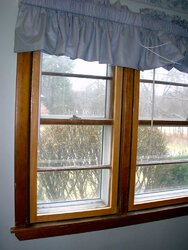Here's the home. Main floor and a basement; northern Wisconsin, 2000 sq ft.; windows double pane, 2x6 walls, well insulated and caulked; attic with 22" insulation, no ice dams; 1/3 of basement is dirt floor crawl space with dirt covered with plastic; 3 exterior doors; had house professionally tested after remodeling myself over the years and would qualify as Energy Star home. Guy said house was "too tight" and needed more fresh air--installed a direct air inlet that I can easily monitor and it does let in cold air down there in the basement; basement to main floor not closed by any doors, straight shot up, no obstructions.
Here's the windows: 1/2 of them 18 years old, double pane, no Argon or Low E; 1/2 of them 3 years old, some of which are Low E, some not, none with Argon (Semco windows--made in WI).
Here's the heating: Wood stove centrally located on main floor, nicely heats living/dining/kitchen and hallway to
bedrooms; 3 bedrooms, 2 baths heated by a hydronic run when it is on, but the wood stove keeps that part of the house compfy generally without being on; basement has it's own hydronic run to keep that 60s (mostly storage and utlities down there).
Woodstove: Hearthstone Heritage, doing a fine job.
Current humidity level in the home: 38 low 40s (after this weekend lots of hours running the clothes dryer on no-heat cycle, and off and on running one bathroom vent fan).
low 40s (after this weekend lots of hours running the clothes dryer on no-heat cycle, and off and on running one bathroom vent fan).
Here's the problem: With the wood stove humming along, no need for upstairs hydronic to be on. If I put it on, would roast us out of the house (right now it is 70--72 in the livingroom and I am wearing shorts--it was -17 last night and 0 outside now). Without the hydronic, no heat under the windows; even if hydronic on, no forced air to move the heat.
What I've done: just bought eight 4" fans, three 8" fans and used the three 10" fans I had previously and aimed them all at the windows--that does a very good but not complete job of clearing the bottom of the windows, some still have some moisture along the bottom, some still have some ice in the lower corners.
I am thinking of building "inner storms" with the heat shrink plastic. I am thinking of next year starting to slowly replace the casements glass with Low E and Argon and not the whole window unit (some of the lower wood parts of the crank-out parts of the casements are looking rough from years of this problem).
Windows stay good until about 5 degrees; lower than that, and the problem starts. Without the fans, major moisture and ice, depending on which room (area with wood stove less effected by the cold).
Any insight would be appreciated--thanks for reading.
Here's the windows: 1/2 of them 18 years old, double pane, no Argon or Low E; 1/2 of them 3 years old, some of which are Low E, some not, none with Argon (Semco windows--made in WI).
Here's the heating: Wood stove centrally located on main floor, nicely heats living/dining/kitchen and hallway to
bedrooms; 3 bedrooms, 2 baths heated by a hydronic run when it is on, but the wood stove keeps that part of the house compfy generally without being on; basement has it's own hydronic run to keep that 60s (mostly storage and utlities down there).
Woodstove: Hearthstone Heritage, doing a fine job.
Current humidity level in the home: 38
 low 40s (after this weekend lots of hours running the clothes dryer on no-heat cycle, and off and on running one bathroom vent fan).
low 40s (after this weekend lots of hours running the clothes dryer on no-heat cycle, and off and on running one bathroom vent fan).Here's the problem: With the wood stove humming along, no need for upstairs hydronic to be on. If I put it on, would roast us out of the house (right now it is 70--72 in the livingroom and I am wearing shorts--it was -17 last night and 0 outside now). Without the hydronic, no heat under the windows; even if hydronic on, no forced air to move the heat.
What I've done: just bought eight 4" fans, three 8" fans and used the three 10" fans I had previously and aimed them all at the windows--that does a very good but not complete job of clearing the bottom of the windows, some still have some moisture along the bottom, some still have some ice in the lower corners.
I am thinking of building "inner storms" with the heat shrink plastic. I am thinking of next year starting to slowly replace the casements glass with Low E and Argon and not the whole window unit (some of the lower wood parts of the crank-out parts of the casements are looking rough from years of this problem).
Windows stay good until about 5 degrees; lower than that, and the problem starts. Without the fans, major moisture and ice, depending on which room (area with wood stove less effected by the cold).
Any insight would be appreciated--thanks for reading.


